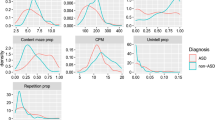Abstract
Asperger syndrome (AS) is differentiated from high-functioning autism (HFA) largely on a history of “language delay.” This study examined “specific language impairment” as a predictor of outcome. Language skills of 19 children with AS and 45 with HFA were assessed at 4–6 years of age (Time 1) and 2 years later (Time 2). Children’s symptoms and functional outcome scores were assessed every 2 years (Times 3, 4, and 5) until ages 15–17 years old. Regression analysis revealed that specific language impairment at time 2 more often accounted for the greatest variation in outcome scores in adolescence than the standard diagnosis of AS versus HFA based on history of language delay. Diagnostic implications are discussed.

Similar content being viewed by others
References
American Psychiatric Association (2000). Diagnostic and statistical manual of mental disorders DSM-IV text revision (4th ed.). Washington DC: American Psychiatric Association.
Chapman, R. S. (2000). Children’s language learning: An interactionist perspective. Journal of Child Psychology and Psychiatry, 41, 33–54.
Cook, R. J. (1987). PC-AGREE—Fortran program based on paper by Holman CDJ:Hamilton, ON.
Fenson, L., Dale, P. S., Reznick, J. S., Bates, E., Thal, D. J., & Pethick, S. (1994). Variability in early communicative development. Monographs of the Society of Research in Child Development, 59, 1–173.
Frith, U. (2004). Emmanuel Miller lecture: Confusions and controversies about Asperger syndrome. Journal of Child Psychology and Psychiatry, 45, 672–686.
Howlin, P. (2003). Outcome in high-functioning adults with autism with and without early language delays: Implications for the differentiation between autism and Asperger syndrome. Journal of Autism and Developmental Disorders, 33, 3–13.
Karmiloff, K., & Karmiloff-Smith, A. (2001). Pathways to language from fetus to adolescent. Cambridge, Massachusetts and London, England: Harvard University Press.
Kjelgaard, M. M., Tager-Flusberg, G. (2001). An investigation of language impairment in autism: Implications for genetic subgroups. Language and Cognitive Processes, 16, 287–308.
Klin, A., Pauls, D., Schultz, R., & Volkmar, F. (2005). Three diagnostic approaches to Asperger Syndrome: Implications for research. Journal of Autism and Developmental Disorders, 35, 221–234.
Krug, D. A., Arik, J. L., & Almond, P. (1980). Behavior checklist for identifying severely handicapped individuals with high levels of autistic behaviour. Journal of Child Psychology and Psychiatry, 21, 221–229.
Leung, A. K. C., & Kao, C. P. (1999). Evaluation and management of the child with speech delay. American Family Physician, 59, 3121–3128.
Levine, M. N. (1986). Arthur adaptation of the Leiter international performance scale: A handbook. Montreal, QC: Institute of Psychological Research.
Liss, M., Fein, D., Waterhouse, L., Allen, D., Dunn, M., Morris, R., & Rapin, I. (2001). Executive functioning in high-functioning children with autism. Journal of Child Psychology and Psychiatry, 42, 261–270.
Lord, C., Rutter, M., & LeCouteur, A. (1994). Autism diagnostic interview-revised: A revised version of a diagnostic interview for caregivers of individuals with possible pervasive developmental disorders. Journal of Autism and Developmental Disorders, 24, 659–685.
Macintosh, K. E., & Dissanayake, C. (2004). Annotation: The similarities and differences between autistic disorder and Asperger’s disorder: A review of the empirical evidence. Journal of Child Pscyhology and Psychiatry, 45, 421–434.
Mahler, M. S., & Furer, M. (1972). Child psychosis: A theoretical statement and its implications. Journal of Autism and Childhood Schizophrenia, 2, 213–218.
Majenemer, A., & Rosenblatt, B. (1994). Reliability of parental recall of developmental milestones. Pediatric Neurology, 10, 304–308.
McCormick, M. C., & Brooks-Gunn, J. (1999). Concurrent health status and maternal recall of events in infancy. Pediatrics, 104, 1176–1181.
Nagy, J., & Szatmari, P. (1986). A chart review of schizotypal personality disorders in children. Journal of Autism and Developmental Disorders, 16, 351–367.
Newcomer, P. L., & Hammill, D. D. (1988). Testof Language Development-2. Toronto: Psycan.
Schopler, E. (1996). Are autism and Asperger syndrome (AS) different labels or different disabilities?. Journal of Autism and Developmental Disorders, 26, 109–110.
Sparrow, S. S., Balla, D. D., & Chichetti, D. V. (1984). Vineland adaptive behavior scales (Survey Form). Circle Pines, MN: American Guidance Service.
SPSS Inc. (2004). SPSS for Windows, Release 13.0.1. Chicago, IL.
Ssucharewa, G. E., & Wolff, S. (1996). The first account of the syndrome Asperger described? Translation of a paper entitled “Die schizoiden Psychopathien im Kindesalter” by Dr. G. E. Swsucharewa; scientific assistant, which appeared in 1926 in the Monatsschrift fur Psychiatrie und Neurologie 60:235–261 European Child and Adolescent Psychiatry 5:119–132.
Stein, M. T., Klin, A., & Miller, K. (2004). When Asperger’s syndrome and a nonverbal learning disability look alike. Journal of Developmental and Behavioral Pediatrics, 25, 58–64.
Szatmari, P., Bryson, S. E., Streiner, D. L., Wilson, F. J., Archer, L., & Ryerse, C. (2000). Two-year outcome of preschool children with autism or Asperger’s syndrome. American Journal of Psychiatry, 1576, 1980–1987.
Szatmari, P. (2000). The classification of autism, Asperger’s syndrome and pervasive developmental disorder. Canadian Journal of Psychiatry, 45, 731–738.
Tager-Flusberg, H. (2004). Strategies for conducting research on language in autism. Journal of Autism and Developmental Disorders, 34, 75–80.
Thorndike, R. L., Hagn, E. P., & Sutter, J. M. (1985). Stanford-Binet Intelligence Scale (4th ed.). Chicago: Riverside.
Toppelberg, C. O., & Shapiro, T. (2000). Language disorders: A 10-year research update review. Journal of the American Academy of Child and Adolescent Psychiatry, 39, 143–152.
Volkmar, F. R., Cicchetti, D. V., Dykens, D., Sparrow, S. S., Leckman, J. F., & Cohen, D. J. (1988). An evaluation of the Autism Behavior Checklist. Journal of Autism and Developmental Disorders, 18, 81–98.
Acknowledgment
This research project was funded by the Ontario Mental Health Foundation. We would like to acknowledge the children and families who have participated so faithfully in this project over several years.
Author information
Authors and Affiliations
Corresponding author
Rights and permissions
About this article
Cite this article
Bennett, T., Szatmari, P., Bryson, S. et al. Differentiating Autism and Asperger Syndrome on the Basis of Language Delay or Impairment. J Autism Dev Disord 38, 616–625 (2008). https://doi.org/10.1007/s10803-007-0428-7
Received:
Accepted:
Published:
Issue Date:
DOI: https://doi.org/10.1007/s10803-007-0428-7




